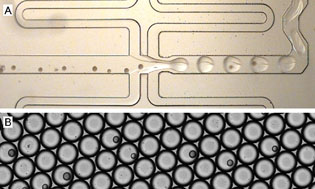News You Can Use
An Intramural Gem
BEPS: Technical Help When and Where You Need It
Beset by poorly quantified analyte concentrations in your micro-immunoaffinity capillary electrophoresis results? Annoyed by what should have been passive microwave thermometry? Has your Quansys enzyme-linked immunosorbent assay (ELISA) array gone awry?
Relax. BEPS has got your back.

CREDIT: (A) MICHAEL KELLY, NIDCD; (B) NICOLE MORGAN, NIBIB
BEPS is helping NIH researchers implement Drop-seq technology for low-cost parallel RNA sequencing of single cells. The technology uses microfluidic devices for co-encapsulation of single cells and bar-coded beads. Shown: (A) the nozzle of a co-encapsulation device showing droplet generation and bead encapsulation; (B) a collection of uniform 100-micrometer-diameter droplets with beads encapsulated.
BEPS—an abbreviation far easier to pronounce than the many technical services this trans-NIH shared resource can provide—stands for Biomedical Engineering and Physical Science. Housed in Building 13, the group supports NIH’s intramural basic and clinical scientists on applications of engineering, physics, imaging, measurement, and analysis. BEPS specializes in atomic-force microscopy; electron microscopy; microfabrication; microfluidics; analytical ultracentrifugation; surface plasmon resonance; microanalytical immunochemistry; thermal imaging; matrix-assisted laser desorption and ionization; inductively coupled plasma optical-emission spectrometry for trace analysis of metals in tissues; and many other techniques. And BEPS’s offerings are available to any NIH intramural researcher.
“Our expertise ranges over length scales from the near-atomic to [the] whole organisms,” said BEPS chief Hank Eden.
BEPS is a gem for those who discover it, said Eden, who also serves as deputy scientific director of intramural research programs at the National Institute of Biomedical Imaging and Bioengineering (NIBIB). Comprising six units, BEPS assists with numerous research projects each year, but NIH researchers often know of it only by word of mouth.
As new technologies arise, however, BEPS hopes to take a more proactive role to ensure no NIH intramural scientist is left behind.
Consider microfabrication. BEPS has an in-house, multi-user facility for low-cost construction of microstructures for a variety of biomedical-research applications, particularly those requiring confinement of cells or the control of cellular environments. BEPS has trained researchers from nine institutes in microfabrication techniques and has recently started working with researchers to get the Drop-seq technology up and working on campus. The method uses microfluidic devices for co-encapsulation of single cells and bar-coded beads to generate high-throughput, low-cost, single-cell gene-expression data.
In the realm of immunochemistry, BEPS can assemble novel immunoassays to quantify concentrations of cytokines, chemokines, neuropeptides, hormones, and other analytes in submicroliter samples. “If an antibody exists for an antigen of interest, we can build the assay,” said Eden.
BEPS goes bench to bedside with thermometry, video microcapillaroscopy, and assessment of peripheral microcirculation. The group has aided in high-resolution infrared imaging to assess blood flow in organs as diverse as rat kidneys and human brains, and it has performed intraoperative and bedside optical imaging of tissue perfusion, oxygenation, and temperature. This same group also has ventured into wireless electronic patches and cellular phone technology for longitudinal monitoring in clinical research.
Many NIHers associate BEPS with microscopy, for good reason. BEPS can help with atomic-force microscopy for subnanometer-resolution imaging of macromolecular complexes (such as protein-protein, protein-DNA, and protein-RNA) and lipid bilayers, cells, and tissues under physiological conditions. BEPS also specializes in cryoelectron microscopy and energy-dispersive X-ray spectroscopy.
If you’re stymied, BEPS may very well be able to help.
“We established BEPS so that no researcher would be compromised by lack of expertise in any new or established technology,” said Michael Gottesman, deputy director for intramural research. “This is a fabulous resource at your fingertips that allows you to reach your utmost research potential that’s simply not available at most research institutions.”
The six BEPS units are the Electron Microscopy Unit, Infrared Imaging and Thermometry Unit, Micro Analytical Immunochemistry, Microfabrication and Microfluidics, Quantitative Methods for Macromolecular Interactions, and the Scanning Probe Microscopy Unit. Refer to http://www.nibib.nih.gov/beps for more information, or contact Hank Eden directly at edenh@mail.nih.gov.
This page was last updated on Monday, April 25, 2022
